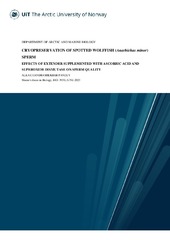On the relative effect of spawning asynchrony, sperm quantity, and sperm quality on paternity under sperm competition in an external fertilizer
Permanent link
https://hdl.handle.net/10037/8001Date
2015-07-14Type
Journal articleTidsskriftartikkel
Peer reviewed
Abstract
How much of a fitness benefit is obtained by dominant males of external fertilizers
from releasing ejaculates in synchrony with female egg-release when engaging in sperm
competition, and what is the most important sperm trait for paternity in these situations?
The Arctic charr (Salvelinus alpinus) is an external fertilizer experiencing intense
male-male competition over reproductive opportunities including sperm competition.
To compensate for their disadvantage the sneaker males, which often spawn out of
synchrony with the female, produce more and faster sperm than the guarding males.
We used controlled in vitro fertilization trials with experimentally produced dominant and
subordinate, sneaker males to test what effect relative synchrony in gamete release,
sperm quality (i.e., motility and velocity) and sperm quantity have on a male’s fertilization
success in pair-wise sperm competitions. When the sneaker males released ejaculates
after the guarding male there was no overall difference in fertilization success. The quality
(i.e., motility and velocity) of a male’s sperm relative to that of the competing male was the
best predictor of male fertilization success regardless of their mating tactic and spawning
synchrony. The relative number of sperm cells also had an effect on fertilization success,
but mainly when the dominant and sneaker male ejaculated synchronously. Our close
imitation of natural sperm competition in charr shows that the sneaker males of external
fertilizing species may fully compensate for their disadvantaged mating role by producing
ejaculates of higher quality—an adjustment strangely not met by dominants.
Publisher
Frontiers MediaCitation
Frontiers in Ecology and Evolution 3(2015) s. 1-Metadata
Show full item recordCollections
The following license file are associated with this item:
Related items
Showing items related by title, author, creator and subject.
-
CRYOPRESERVATION OF SPOTTED WOLFFISH (Anarhichas minor) SPERM EFFECTS OF EXTENDER SUPPLEMENTED WITH ASCORBIC ACID AND SUPEROXIDE DISMUTASE ON SPERM QUALITY
Pandey, Alka Chandrashekhar (Master thesis, 2025)The spotted wolffish (Anarhichas minor) holds considerable promise for cold-water aquaculture due to its high fillet yield, docile behaviour, and resistance to disease. However, reproductive constraints—including limited sperm motility, low ejaculate volume, and narrow spawning windows—impede large-scale hatchery production. Cryopreservation offers a strategic solution for overcoming these limitations ... -
The relative effect of parasites and social status on sperm traits in Arctic charr
Figenschou, Lars; Folstad, Ivar; Rudolfsen, Geir; Hanssen, Sveinn Are; Kortet, Raine; Skau, Philip; Killie, Jan Eirik; Oskam, Irma Caroline; Strand, Harald (Journal article; Tidsskriftartikkel; Peer reviewed, 2013)Sperm production and sperm swimming speed, which most likely affect fertilization under sperm competition, are modified by proximate mechanisms. In a comprehensive observational study of free-living and reproductively active Arctic charr (Salvelinus alpinus), we examined the possible modulating effects of male social status (including ornamental development), parasite intensities, and immunity ... -
Status specific tailoring of sperm behavior in an external fertilizer
Egeland, Torvald Blikra; Rudolfsen, Geir; Nordeide, Jarle Tryti; Folstad, Ivar (Journal article; Tidsskriftartikkel; Peer reviewed, 2016-11-24)Why dominant males experiencing intense sperm competition sometimes show low investments in sperm production is not always obvious. One well-documented example is that of the external fertilizing teleost, the Arctic charr (Salvelinus alpinus), where individuals becoming dominant reduce sperm production and sperm swimming speed in water compared to subordinates. Here, we report how ovarian ...


 English
English norsk
norsk


